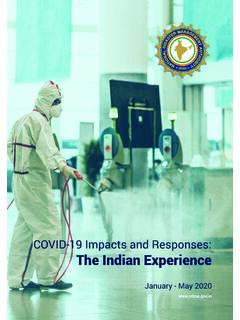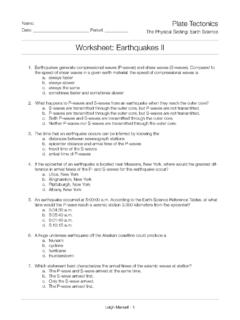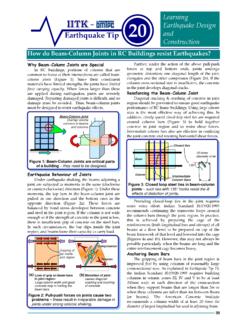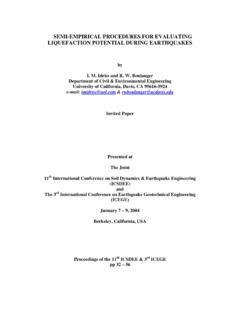Transcription of NATIONAL DISASTER MANAGEMENT GUIDELINES
1 NATIONAL DISASTER MANAGEMENT GUIDELINESMANAGEMENT OF EARTHQUAKESA pril 2007 Produced by: Magnum Books Pvt Ltd, +91-98110 97054 NATIONAL DISASTER MANAGEMENT AUTHORITYGOVERNMENT OF INDIAI ndex PreviousNextiiIndex PreviousNextiNational DisasterManagement GuidelinesManagement of EarthquakesIndex PreviousNextiiIndex PreviousNextiiiNational DisasterManagement GuidelinesManagement of EarthquakesNational DISASTER
2 MANAGEMENT AuthorityGovernment of IndiaIndex PreviousNextivIndex PreviousNextvVisionZero Tolerancetoavoidable deaths due to earthquakesMissionTo formulate GUIDELINES for the preparation of plans to reduceearthquake risk, and minimise the impact, loss of lives and damageto property caused by earthquakesIndex PreviousNextviIndex PreviousNextviiVision and Mission vTable of Contents viiForeword xiAcknowledgements xiiiAbbreviations xvGlossary of Terms xviiiList of Tables xxList of Figures xxExecutive Summary 1 1 The Context Risk and Vulnerability in India Housing Construction in Rural Areas Areas of Concern
3 In earthquake MANAGEMENT of Past Initiatives in Recent Initiative in Engineering Approach to earthquake Framework for earthquake Mechanisms for Implementation13 2 GUIDELINES An for earthquake earthquake Six Pillars of earthquake Line for Implementation14 3 earthquake -Resistant Designand Construction of New Need for Making All New Constructions and Milestones17 Table of ContentsIndex of earthquake -Resistant Design and for Compliance of Seismic Safety of New Constructions18 4 Seismic Strengthening and Retrofittingof Lifeline and Priority for Seismic Strengthening of Existing of Safety Audit of Critical Lifeline Awareness Strengthening and Allocations for Carrying out Selective Retrofitting22 5 Regulation and Codes and Other Safety and Certification of Construction in Rural and Semi-Urban for Regulation and Enforcement28 6 Awareness and Drives for Specific Target MANAGEMENT for Awareness and Preparedness Activities31
4 7 Capacity Development (including Education,Training, R&D and Documentation) Building of OF CONTENTSI ndex for Capacity Building (including Education,Training, R&D, and Documentation)37 Search and Command System (ICS) Based DISASTER of the Corporate Teams for earthquake Medical for Response Activities41 9 DISASTER MANAGEMENT Plans Ministry and Department Plans of State of Nodal Agencies45 Contributions46 TABLE OF CONTENTSI ndex PreviousNextxIndex PreviousNextxiVice ChairmanNational DISASTER MANAGEMENT AuthorityGovernment of IndiaFOREWORDP reparation of GUIDELINES for various types of disasters forms an
5 Important part of the mandate ofthe NATIONAL DISASTER MANAGEMENT Authority (NDMA). Almost 59 percent of the landmass of India isprone to earthquakes and preparation in this regard constitutes an important part of our effort for bettermanagement of disasters in the Country. For that reason, soon after being constituted, a series ofconsultations were initiated by the NDMA, with various stakeholder groups to formulate consultations included representatives of various central ministries and departments, scientificand technical institutions, academics, technocrats, architects and humanitarian organizations.
6 The firstsuch meeting was held on 21 December 05. It reviewed the status of earthquake MANAGEMENT effortsthus far, identified gaps and set the framework for the approach. Thereafter, a Core Group was constitutedto prepare the GUIDELINES . Their work, which extended over six months, was reviewed by an ExtendedGroup during a number of deliberations. The GUIDELINES were finalized after two NATIONAL workshops atIIT Kanpur and IIT Mumbai and vetting by the ministries is evident, these GUIDELINES are an outcome of the effort of over 300 leading experts in theCountry.
7 These call for a participatory approach involving all stakeholder groups to strengthen the nationalvision of moving towards a more proactive pre- DISASTER preparedness and mitigation-centric contain all the details that are required by the planners and implementers and will help in thepreparation of plans by the central ministries and the states. A NATIONAL level earthquake MitigationProject will also be undertaken for all the earthquake prone districts to back the above effort. I am surethat these GUIDELINES will serve the purpose take this opportunity to express my deep appreciation of the commitment of various stakeholdergroups who extended their willing support and cooperation to our efforts.
8 I am grateful to the membersof the Core Group, who put in endless hours of work. I also wish to convey my gratitude to themembers of the NDMA, Extended Group, and other experts whose contributions have resulted into thepreparation of these GUIDELINES . And finally, I am also pleased to place on record my sincere appreciationfor Prof. N. Vinod Chandra Menon, Member, NDMA, who guided and coordinated the entire DelhiGeneral NC Vij30 April 2007 PVSM, UYSM, AVSM (Retd)Index PreviousNextxiiIndex PreviousNextxiiiACKNOWLEDGEMENTSI am grateful to the members of the Core Group who contributed to the preparation of the NationalDisaster MANAGEMENT GUIDELINES for the MANAGEMENT of Earthquakes.
9 I must place on record mysincere appreciation of the special efforts made by Prof. Ravi Sinha of IIT Mumbai and Prof. of IIT Kanpur as well as the valuable inputs and feedback from Dr. Bhandari, Chairman,CDMM, Vellore and Prof. Arya, NATIONAL Seismic Advisor, Government of India. I am also gratefulto the professionals in scientific and technical institutions, various Ministries of the Government of India,Relief Commissioners from State Governments and other key stakeholders for their valuable insightswhich have contributed immensely in shaping these am deeply indebted to Gen.
10 Vij, PVSM, UYSM, AVSM (Retd), Vice Chairman, NDMA forhis valuable guidance and constructive criticism at various stages of the preparation of the GUIDELINES ,which substantially improved the focus and operationalisation strategy. I must also acknowledge mygratitude to the distinguished Members of the NDMA for their valuable insights, guidance and am also happy to acknowledge the support extended by Ms. Rani Sahay, Mr. Vivek Sharma,Mr. K. Vijaya Kumaran, Mr. Satish Chandra Sharma and Mr. Thomas Kutty during the variousworkshops and their assistance in the preparation of these support of Mr.









